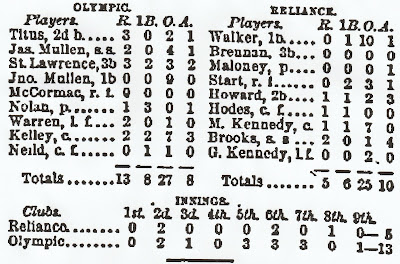The Neshanock's annual Memorial Day visit to Pickering Field in Newtowon, Pennsylvania was rained out, Flemington returns to action on Saturday, June 11th at the Howell Living History Farm in Lambertville, New Jersey against the Elkton Eclipse.
Back in early April, I was asked to speak about 19th century base ball at the New Jersey State Library in Trenton. As per usual, I tried to find a few local references in addition to the broader topics of the early game and more specifically its development in New Jersey. In the process, I remembered some thing I had seen regarding what may have been one of the first enclosed base ball grounds in the state. The facility was constructed in Trenton, but what was interesting was the reference to its location near the Soldier's Children's Home at Hamilton and Chestnut Avenues. I was well aware of several soldier's homes in New Jersey built for the aging, ill and impoverished Civil War veterans, but had never seen anything regarding the children (or more properly the orphans) of Union soldiers. Not surprisingly some Internet searching revealed more information including the finding aid for the facility's records which are housed in the State archives. Even more detailed information was available in an 1872 report of an investigation of alleged abuses at the facility.
Soldier's Children's Home of New Jersey
Coincidentally and simultaneously with learning about the Soldier's Children's Home, I'm reading Brian Jordan's book, Marching Home: Union Veterans and Their Unending Civil War which along with this weekend's observation of Memorial Day, started in 1868 to honor the Union dead, made the home, a timely topic for a blog post. Jordan's book, based on what seems to be exhaustive research, details the many problems and issues Union soldiers faced when they tried to adjust to living in a civilian society that wanted to put the war behind them. As it difficult it was for the veterans, and it was difficult, at least they had their own voices and those of others, including some prominent politicians to speak up for them. The dead, of course, had no voice nor the ability to help those who Lincoln in his second inaugural so eloquently (and concisely) described as "his widow and his orphan."
New Jersey Governor - Joel Parker
Portion of a letter from the Trenton State Gazette, February 20, 1866 urging the establishment of the Soldier's Children's Home
One of the sad things about this story is how little information survives (at least that which is available through the Internet) about these "benevolent ladies," without whom the idea would most likely never have come to fruition. The original president was a Mrs. A. O. Zabriskie from Jersey City who resigned in November of 1865 and was succeeded by Margaret Dayton of Trenton, who continued as president throughout the home's existence. Mrs. Dayton was the widow of William Dayton, Republican vice presidential candidate in 1856 and U. S. Ambassador to France, who died in Paris in 1864, according to at least one historian, under somewhat mysterious circumstances. Internet searches for information about Mrs. Dayton and her three major helpers Mary A. Hall, Mary F. Johnston and Mary G. Abbot, produced almost nothing. In fact, Mrs. Dayton's 1892 obituary makes no mention of her eleven year long leadership of the home. Mary Hall, served as treasurer, like Mrs. Dayton for over a decade, while Mary Johnston and Mary Abbott split the secretarial duties. This tells us little or nothing about them,but their names are included here so that their efforts (mostly without pay) are at least in a small way, not completely forgotten.
General Gershom Mott
William McDaniels Grave - Cold Harbor National Cemetery, Virginia
Abraham Snyder's Grave - Andersonville National Cemetery
As valuable as all of this information may be, it's impossible to get a full sense of the story without trying to put a human face on the people involved. The finding aid in the state archives included about 15 or so names of both the child and the veteran and from that small sample, three stories were available in pension files. At least one child of Abraham Snyder from Hainesburg in Warren County lived in the home after his/her father, a member of the 35th New Jersey died of disease in Andersonville Prison. Snyder's death in the service of his country, left his widow, Susan with five children under the age of ten and it's not surprising she needed help with at least one of them. Less clear is the story of Peter Dorus, an African-American man from Hillsborough in Somerset County, who also with five children, enlisted in the 127th Regiment of U.S. Colored Troops and died of disease in route to a hospital in Virginia. Little information about the family could be found, but it appears his widow, Martha, couldn't keep the family together and placed one child, Frances in the home. Leaving only one child was William McDaniels from Bordentown (12th New Jersey), but one who was especially vulnerable since it appears his mother known as "Railroad Mag," used her pension money to support a scandalous life style, while abandoning her son, William to the home.
Peter Dorus's grave - Fort Harrison National Cemetery, Virginia
There are doubtless far more stories in the records in the state archives that would make a worthy project for a Civil War researcher or New Jersey historian. But on Memorial Day 2016, I hope this post helps us to remember the story of a time when elected officials and dedicated volunteers came together to honor in a very real way those who "gave their lives that that nation might live." As the investigating committee noted, "It is impossible, not to look with profound sympathy upon the two hundred fatherless and motherless children." Thanks to Margaret Dayton and the three Marys, plus countless unnamed others, the people of that time backed up their sympathy in a real and tangible manner.




























